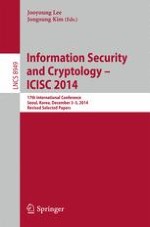This book constitutes the thoroughly refereed post-conference proceedings of the 17th International Conference on Information Security and Cryptology, ICISC 2014, held in Seoul, South Korea in December 2014. The 27 revised full papers presented were carefully selected from 91 submissions during two rounds of reviewing. The papers provide the latest results in research, development and applications in the field of information security and cryptology. They are organized in topical sections on RSA security, digital signature, public key cryptography, block ciphers, network security, mobile security, hash functions, information hiding and efficiency, cryptographic protocol, and side-channel attacks.
